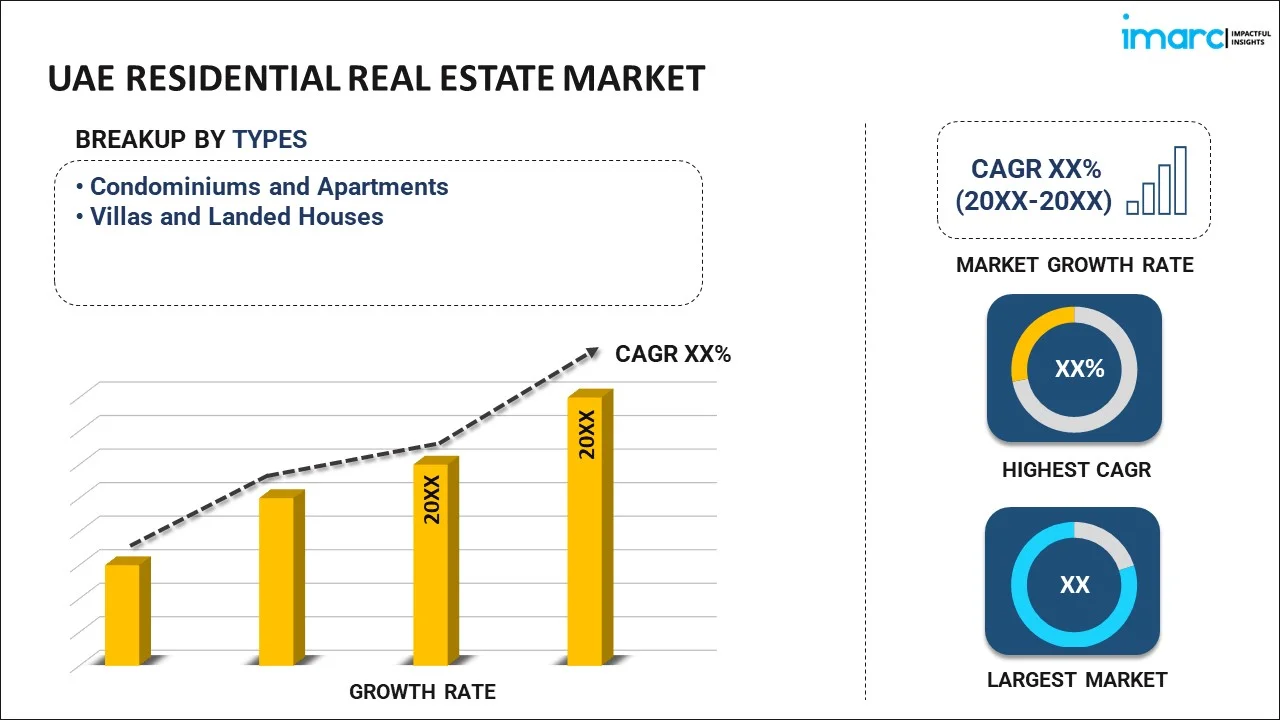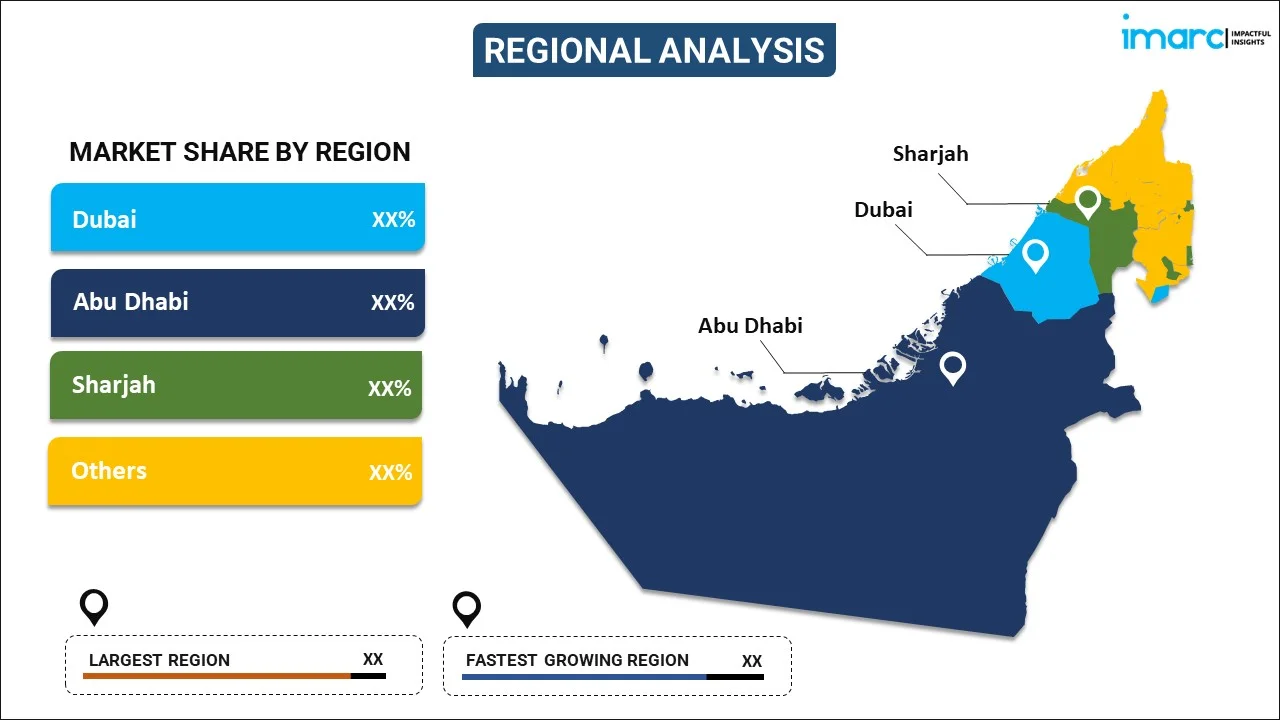
UAE Residential Real Estate Market Report by Type (Condominiums and Apartments, Villas and Landed Houses), and Region 2025-2033
UAE Residential Real Estate Market Overview:
The UAE residential real estate market size reached USD 18.3 Billion in 2024. Looking forward, IMARC Group expects the market to reach USD 35.4 Billion by 2033, exhibiting a growth rate (CAGR) of 7.1% during 2025-2033. The rising population growth, government initiatives like long-term visas, high urbanization rates, economic diversification, infrastructural development, attractive financing options, a stable political environment, and the country’s strategic locations are some of the major factors propelling the market growth.
|
Report Attribute
|
Key Statistics
|
|---|---|
|
Base Year
|
2024 |
|
Forecast Years
|
2025-2033 |
|
Historical Years
|
2019-2024
|
| Market Size in 2024 | USD 18.3 Billion |
| Market Forecast in 2033 | USD 35.4 Billion |
| Market Growth Rate (2025-2033) | 7.1% |
UAE Residential Real Estate Market Trends:
Rising Population Growth and Urbanization
Rapid population growth and high rates of urbanization in cities like Dubai and Abu Dhabi increase the demand for residential properties. According to the United Nations Development Programme, In the Arab region, the total population residing in urban areas is expected to grow to 58% by 2030. The level of urbanization varies significantly across the different subregions. The level of urbanization varies significantly across the different subregions. The urban population is projected to increase across all subregions. In the Mashreq, the population will reach 121.6 million by 2030. In the Maghreb, the population is expected to grow to 82.6 million by 2030. The GCC countries will also see an increase, reaching 54.6 million by 2030. Meanwhile, in the STC region, the population is projected to rise to 45.2 million by 2030. The most urbanized subregion is the GCC (82.2% in 2015 and projected at 84.3% in 2030). The least urbanized area is the STC (34.6% in 2015 and 40.6% in 2030). The ranking of the subregion's urban population will not change in 2030, but the STC subregion will come very close to the GCC subregion.
Growing Government Initiatives and Policies
Long-term residency visas, property ownership rights for expatriates, and government incentives attract foreign investments and bolster market confidence. For instance, in May 2024, the United Arab Emirates launched a 10-year Blue Residency visa for individuals who have made ‘exceptional efforts and contributions to protecting the environment, whether marine or land’. The new visa was announced by Sheikh Mohammed bin Rashid, Prime Minister and Ruler of Dubai. In a post on social media platform X, he said, “The year 2024 will be the year of sustainability. Today we approved the “Blue Residency” which is a long-term residency for a period of 10 years that will be granted to individuals with exceptional contributions and efforts in the field of protecting the environment, whether marine or land or the quality of the air environment, sustainability and its modern technologies, the circular economy, or other fields.”
UAE Residential Real Estate Market News:
- In May 2024, DMCC and Signature Developers partnered to launch W Residences at Jumeirah Lakes Towers (JLT). It is expected to break ground by the end of the year and set new standards for exceptional hotel living in the vibrant JLT community, DMCC said in a statement.
- In May 2024, Hilton and Al Hamra revealed plans for the introduction of Waldorf Astoria Residences Ras Al Khaimah, set to open in 2026. It marks the debut of the first Waldorf Astoria Residences as part of a managed resort in the UAE.
UAE Residential Real Estate Market Segmentation:
IMARC Group provides an analysis of the key trends in each segment of the market, along with forecasts at the country level for 2025-2033. Our report has categorized the market based on type.
Type Insights:

- Condominiums and Apartments
- Villas and Landed Houses
The report has provided a detailed breakup and analysis of the market based on the type. This includes condominiums and apartments and villas and landed houses.
Regional Insights:

- Dubai
- Abu Dhabi
- Sharjah
- Others
The report has also provided a comprehensive analysis of all the major regional markets, which include Dubai, Abu Dhabi, Sharjah, and Others.
Competitive Landscape:
The market research report has also provided a comprehensive analysis of the competitive landscape in the market. Competitive analysis such as market structure, key player positioning, top winning strategies, competitive dashboard, and company evaluation quadrant has been covered in the report. Also, detailed profiles of all major companies have been provided.
UAE Residential Real Estate Market Report Coverage:
| Report Features | Details |
|---|---|
| Base Year of the Analysis | 2024 |
| Historical Period | 2019-2024 |
| Forecast Period | 2025-2033 |
| Units | Billion USD |
| Scope of the Report | Exploration of Historical and Forecast Trends, Industry Catalysts and Challenges, Segment-Wise Historical and Predictive Market Assessment:
|
| Types Covered | Condominiums and Apartments, Villas and Landed Houses |
| Regions Covered | Dubai, Abu Dhabi, Sharjah, Others |
| Customization Scope | 10% Free Customization |
| Post-Sale Analyst Support | 10-12 Weeks |
| Delivery Format | PDF and Excel through Email (We can also provide the editable version of the report in PPT/Word format on special request) |
Key Questions Answered in This Report:
- How has the UAE residential real estate market performed so far and how will it perform in the coming years?
- What has been the impact of COVID-19 on the UAE residential real estate market?
- What is the breakup of the UAE residential real estate market on the basis of type?
- What are the various stages in the value chain of the UAE residential real estate market?
- What are the key driving factors and challenges in the UAE residential real estate?
- What is the structure of the UAE residential real estate market and who are the key players?
- What is the degree of competition in the UAE residential real estate market?
Key Benefits for Stakeholders:
- IMARC’s industry report offers a comprehensive quantitative analysis of various market segments, historical and current market trends, market forecasts, and dynamics of the UAE residential real estate market from 2019-2033.
- The research report provides the latest information on the market drivers, challenges, and opportunities in the UAE residential real estate market.
- Porter's five forces analysis assist stakeholders in assessing the impact of new entrants, competitive rivalry, supplier power, buyer power, and the threat of substitution. It helps stakeholders to analyze the level of competition within the UAE residential real estate industry and its attractiveness.
- Competitive landscape allows stakeholders to understand their competitive environment and provides an insight into the current positions of key players in the market.
Need more help?
- Speak to our experienced analysts for insights on the current market scenarios.
- Include additional segments and countries to customize the report as per your requirement.
- Gain an unparalleled competitive advantage in your domain by understanding how to utilize the report and positively impacting your operations and revenue.
- For further assistance, please connect with our analysts.
 Inquire Before Buying
Inquire Before Buying
 Speak to an Analyst
Speak to an Analyst
 Request Brochure
Request Brochure
 Request Customization
Request Customization




.webp)




.webp)












